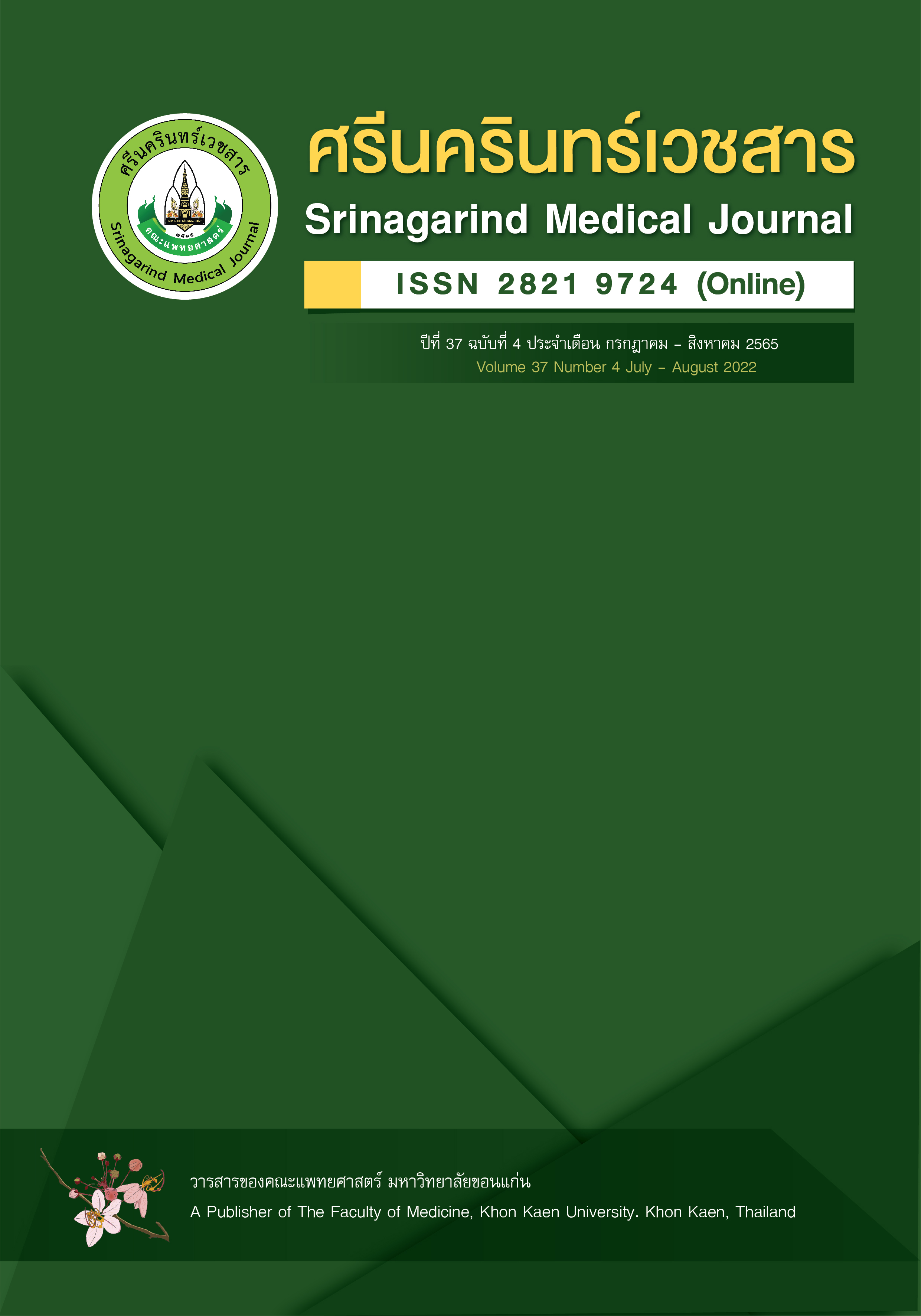การเข้าถึงข้อมูลการดูแลรักษาของผู้ป่วยปากแหว่ง เพดานโหว่ ช่วงระยะตั้งครรภ์จนถึงอายุ 5 ปี ในพื้นที่จังหวัดขอนแก่น
Access to Information, Treatment Care for Patients with Cleft Lip and Palate from Pregnancy to 5 Years of Age in Khon Kaen Province
Abstract
การเข้าถึงข้อมูลการดูแลรักษาของผู้ป่วยปากแหว่ง เพดานโหว่ ช่วงระยะตั้งครรภ์จนถึงอายุ 5 ปี ในพื้นที่จังหวัดขอนแก่น
ฐิตินันท์ สุพรรณคุ้ม1, นงลักษณ์ แสนธารณะ1, ชิโนรส ปิยกุลมาลา2, ยุพิน ปักกะสังข์3, สุธีรา ประดับวงษ์2*, บวรศิลป์ เชาวน์ชื่น1
1 มูลนิธิตะวันฉาย เพื่อผู้ป่วยปากแหว่ง เพดานโหว่ และพิการทางศีรษะและใบหน้า
2 ศูนย์วิจัยผู้ป่วยปากแหว่ง เพดานโหว่ และความพิการแต่กำเนิดของศีรษะและใบหน้า มหาวิทยาลัยขอนแก่น
3 แผนกการพยาบาลศัลยกรรมและออร์โธปิดิกส์ งานบริการพยาบาล โรงพยาบาลศรีนครินทร์ คณะแพทยศาสตร์ มหาวิทยาลัยขอนแก่น
Access to Information, Treatment Care for Patients with Cleft Lip and Palate from Pregnancy to 5 Years of Age in Khon Kaen Province
Titinan Suphankhum1, Nongluk Saentarana1, Chinorose Piyakulmala2, Yupin Paggasang3, Suteera Pradubwong2*, Bowornsilp Chowchuen1
1 Tawanchai Foundation for Cleft Lip, Cleft Palate and Craniofacial Deformities
2 Research Center of Cleft Lip-Cleft Palate and Craniofacial Deformities, Khon Kaen University
3 Surgical and Orthopedic Department, Division of Nursing, Srinagarind Hospital, Faculty of Medicine, Khon Kaen University
หลักการและวัตถุประสงค์: ปากแหว่งเพดานโหว่ส่งผลกระทบรุนแรงต่อผู้ป่วยและครอบครัว ใช้เวลารักษานาน การเข้าถึงข้อมูลการดูแลเป็นสิ่งสำคัญ จึงต้องการทราบการเข้าถึงข้อมูลการรักษาว่าเป็นอย่างไร
วิธีการศึกษา: การศึกษาเชิงพรรณนาในมารดาที่มีบุตรปากแหว่งเพดานโหว่จังหวัดขอนแก่น ที่เข้ารับการรักษากับศูนย์ตะวันฉาย ตั้งแต่แรกเกิด ถึง 5 ปี โดยการสัมภาษณ์เชิงโครงสร้างทางโทรศัพท์ 15 นาทีต่อราย เก็บข้อมูลทั่วไป การเข้าถึงข้อมูลการดูแลรักษา ระหว่างตั้งครรภ์ ระหว่างการรักษา และสิทธิในการรักษา สรุปวิเคราะห์ข้อมูลและใช้สถิติร้อยละ
ผลการศึกษา: มีผู้ป่วยในระบบ 44 ราย สัมภาษณ์ได้ 36 ราย (ร้อยละ 81.82) ส่วนใหญ่เป็นเพศหญิง อยู่ในช่วงอายุ 0-2 ปี และมีทั้งภาวะปากแหว่ง เพดานโหว่ ร้อยละ 63.88, 66.66 และ 47.22 ตามลำดับ การเข้าถึงข้อมูลการดูแลระยะตั้งครรภ์ พบว่า เข้าถึงข้อมูลคำแนะนำในการเตรียมตัวก่อนตั้งครรภ์ ปัจจัยเสี่ยงต่างๆ และโอกาสเกิดซ้ำค่อนข้างน้อย (ร้อยละ 37.50) หลังตั้งครรภ์ 3 เดือน เข้าถึงข้อมูลคำแนะนำเพิ่มขึ้นร้อยละ 62.86 แรกคลอด-6 เดือน เข้าถึงข้อมูลการดูแลเพิ่มมากขึ้นร้อยละ 82.76 และเข้าถึงข้อมูลคำแนะนำก่อนและหลังการผ่าตัดเพดานโหว่ รวมทั้งสิทธิและการช่วยเหลือร้อยละ 100
สรุป: การเข้าถึงข้อมูลการเตรียมตัวก่อนตั้งครรภ์ ปัจจัยเสี่ยงต่างๆ โอกาสเกิดซ้ำและการป้องกันค่อนข้างน้อย ส่วนข้อมูลการดูแลรักษา สิทธิและการช่วยเหลือเข้าถึงได้ดี การวางแผนเชิงรุกเพื่อป้องกันการเกิดปากแหว่งเพดานโหว่ เป็นสิ่งสำคัญที่ทีมจะต้องดำเนินการต่อไป
คำสำคัญ: การเข้าถึงข้อมูลการดูแลรักษา, ปากแหว่ง, เพดานโหว่, ศูนย์ตะวันฉาย, จังหวัดขอนแก่น
Background and Objectives: Cleft lip and palate (CLP) have a severe impact on patients and their families, it usually takes a long time for treatment care. Therefore, we want to know about the accessibility of care plan of the CLP patients.
Methodology: The descriptive study of mothers with CLP children in Khon Kaen province who received treatment at the Tawanchai Center from birth to 5 years. It takes 15 minutes per person by telephone interview to collect general data such as information accessibility during pregnancy or during taking treatment, and patient right of treatment. The data will be analyzed and shown in percentage statistics.
Results: There were 44 systemic patients, 36 of which were interviewed (81.82 percent), mostly female, they were in the age range of 0-2 years and had both cleft lip and cleft palate at 63.88%, 66.66 and 47.22% respectively. The access of information during pregnancy of pre-pregnancy preparation, various risk factors, and the chance of recurrence was relatively low by 37.50%. After 3 months of pregnancy, information assessment of care plan had increased by 62.86%, from birth to 6 months, information assessment of care plan had increased by 82.76%. Lastly, information assessment of receiving palatoplasty treatment and patient rights were 100%.
Conclusion: Information accessibility of pre-pregnancy preparation, various risk factors, the chances of recurrence and protection are relatively low, while information assessment of receiving palatoplasty treatment and patient rights are good. Proactive planning to prevent CLP is the important concern for the team to continue.


